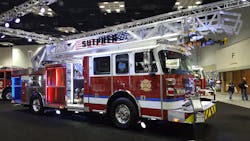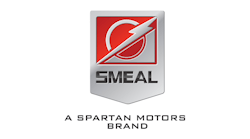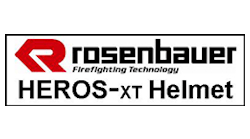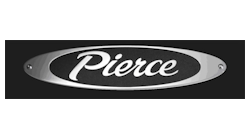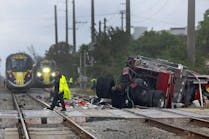INDIANAPOLIS – It seemed like the year of the aerial at FDIC 2016, with virtually all of the major apparatus manufacturers introducing new configurations or substantial improvements to existing designs. E-ONE, Ferrara, HME/Ahrens Fox, Pierce, Rosenbauer, Smeal and Sutphen were all exhibiting new products on the show floor.
E-ONE had a steel platform aerial on display, its first since introducing steel to its product line last year. Ferrara displayed the Skyflow, an aerial with the largest water flow on an aerial ever. HME Ahren/Fox showed off its first fully electronically controlled aerial. Pierce had several variants of its 107-foot, single-axle Asendent product showcased. Rosenbauer showcased a new single-axle, mid-mount platform. Smeal prominently displayed an upgraded articulating Snorkel boom platform, and Sutphen unveiled a rear-mount straight-stick aerial, the first of its kind for the company, which has historically made only mid-mount aerials.
E-ONE
E-ONE’s HPS 100 steel platform aerial, which is ready for delivery to Ocala, FL, held a prominent space in the company’s booth. Jim Salmi, E-ONE’s director of aerial product development, explained that the new apparatus employs all the same “DNA” as previous E-ONE aerials, with some enhancements. He said the new steel platform has the same under-slung jack system with a tight 15-foot, 8-inch spread. He added that the jack configuration also provides more compartment space, which, with other manufacturers, is usually consumed by stabilization equipment.
Salmi added that E-ONE used high-strength DOMEX steel in the construction of the new aerial to keep the weight of the aerial as close to the aluminum counterpart as possible. Salmi explained that the new aerial is wider than his competitors and has higher hand rails as well, making for better access. He added that the the new platform aerial has a tip load rating of 1,000 pounds dry and 500 pounds while flowing 1,500 gpm of water.
“We kept all the good stuff, the good DNA, and made this steel platform aerial,” Salmi said.
Ferrara
Over the years, Ferrara has become known for innovative apparatus at FDIC, and it did not disappoint this year. The company had what it called “the most powerful aerial in the world” on display, capable of flowing more than 5,000-gpm from a 100-foot aerial. According to Ferrara, the apparatus has been engineered to combat the stresses and reaction forces created by fire flow rates in excess of 5,000 gpm. It has a 1,250-pound dry tip load for rescue operations and also has no restrictions on aerial position or extension up to 100 feet for the maximum flow rate.
The unit is supplied with water from a US Fire Pump HVP pump with an 8-inch discharge piped to the aerial swivel. The aerial water way is maximized dimensionally to achieve the 5,000-gpm-plus flow rate.
HME/Ahren Fox
HME first introduced its own line of aerials in 2014, and the company has been making advancements in its product offerings ever since.
The company offered its first fully electronic aerial controls at the show. The control pedestal is compact and tidy, providing additional space on the turntable where it’s needed most. The joystick gives the operator total control over the aerial, and an electronic screen provides all the information needed. A company spokesman said the device uses “envelop control,” which has increasingly become an industry standard. The controls prevent unsafe operations and will bed the aerial automatically.
Manual override controls, with levers that control the hydraulics, are conveniently located behind an access panel at the rear of the apparatus.
Pierce
Pierce dominated the Lucas Oil Stadium with a fleet of apparatus, including several new configurations of its Ascendant 107-foot heavy-duty ladder built on a single rear-axle chassis.
Mike Moore, Pierce’s vice president of business development, walked attendees through the booth, pointing out the new configuration of the wildly popular Ascendant aerial. Moore said Pierce has made an Ascendant with a “Texas Chute Out” body style with a side stack hosebed. It also now has a no pump/no tank body version, which easily allows departments to comply with NFPA standards for a full aerial with the requisite number of ground ladders.
The Ascendant is also available in a PUC configuration, Moore added. Several years ago, Pierce developed the Pierce Ultimate Configuration (PUC), which has the pump located largely under the cab.
“We’re offering our customers a variety of configurations so they can get exactly what they want,” Moore said.
Pierce has reported that the Ascendant has become the most popular new aerial apparatus product offering in the history of Pierce, with more than 60 orders in less than a year.
Rosenbauer
Every year, Rosenbauer fills its booth space with a variety of apparatus, some with very unique features and this year is no exception.
Dave Reichman, Rosenbauer America’s national sales manager, showed off a mid-mount, 75-foot platform aerial that the company had built on a single-axle, custom cab and chassis. Specifically, it is built on a Rosenbauer cab and chassis with a 500-hp engine and an Allison 4000EVS transmission. It also has a 35,000-pound single rear axle, a 2,000-gpm Rosenbauer pump, and a 500-gallon tank.
One of the most important features, Reichman said, is the fact that the aerial has hot-dip galvanized frame rails. He pointed out small drilled holes in the rungs and rails that allows the hot galvanizing zinc to flow to the interior parts of the aerial structure. He said aerials often rust from the inside out, and adding the galvanizing process helps prevent that from happening.
The galvanized surface is a shiny silver, which some customers appreciate, but for those customers who want something different, Reichman said Rosenbauer will paint the surfaces virtually any color.
“We think this apparatus will fit nicely into the fleets of fire departments in the Northeast,” Reichman said, adding that it is offered to any customers anywhere.
Smeal
Standing up, making a nearly perfect A-shape in the middle of the convention center, was Smeal’s new 55-foot Snorkel articulating boom platform aerial. The apparatus, made by Smeal’s Ladder Tower Company division, was the first of its kind built since Smeal acquired the company in 2014.
The apparatus was built for the Frankfort, IL, Fire Protection District and it will replace a 100-foot rear-mount platform.
The Snorkel made a huge impact in the fire service when it was first introduced in 1958 by revolutionizing firefighters’ ability to reach out, over and up for rescues, aerial attack and master stream operations.
The Snorkel is light enough to be mounted on a single-axle, short-wheelbase chassis, providing additional maneuverability, and the A-style stabilizers provide a narrow spread of 11-feet, 9-inches. It has a low travel height of 11-feet, 4-inches.
“Since we purchased LTC, bringing back the Snorkel was a major priority,” said Jeff Wegner, senior vice president of global sales for LTC and Smeal. “There are many fire departments that have been using a Snorkel for years, who absolutely wouldn’t give up its unique ability to get to the fire or rescue. …This was an intensive effort to make the Snorkel better than it’s ever been and we feel confident that we’ve achieved that.”
Sutphen
For decades, Sutphen has been producing aerials one way—mid-mounted—but this year, the family-owned company made a huge change. The company owners had an unveiling of a new rear-mount Sutphen, the first ever of its kind.
During the unveiling, Julie Sutphen, president of Sutphen Towers, said they’ve had customers asking for rear-mount aerials for a long time.
“We listened and we’re very, very excited to debut this product today,” Julie Sutphen said.
Sutphen spokesman David Stonitsch, owner of South Florida Emergency Vehicles, said Sutphen customers have always appreciated the company’s quality but wanted options.
“This is the new tool for the tool box,” Stonitsch said. “Our customers have said, if nothing about the Sutphen ladder, it’s where you mount it on the truck, so all we did is take it and turn it around.”
The new aerial as it was presented had a 62-inch extended cab with a flat roof, a 206-inch wheelbase, a 12-foot, 1.75-inch travel height and a 36-foot, 2-inch travel length.
“It is one great product,” Stonitsch said. “I salute the Sutphen team; you’ve done a fantastic job.’
Firehouse® has no affiliation with FDIC®, which is owned and produced by PennWell.
